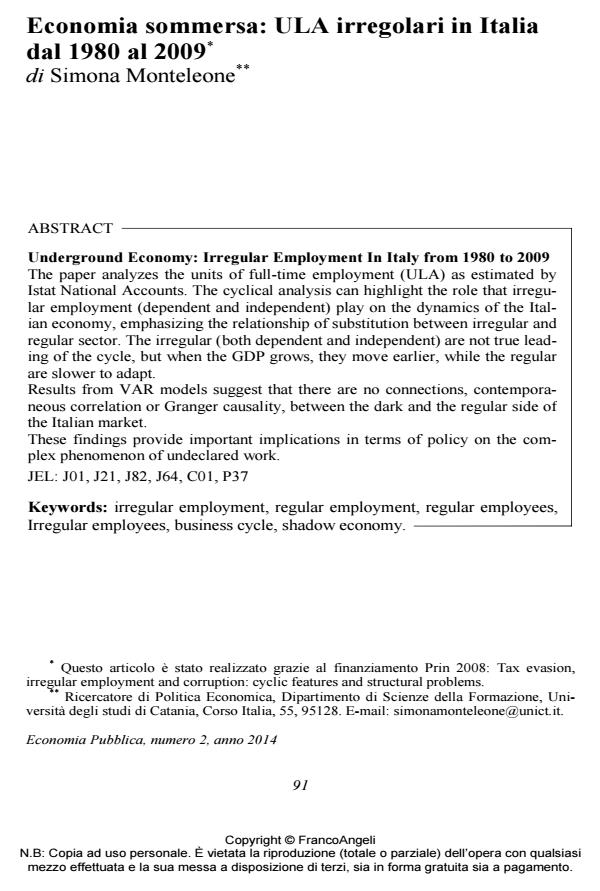Economia sommersa: ULA irregolari in Italia dal 1980 al 2009
Titolo Rivista ECONOMIA PUBBLICA
Autori/Curatori Simona Monteleone
Anno di pubblicazione 2014 Fascicolo 2014/2 Lingua Italiano
Numero pagine 33 P. 91-123 Dimensione file 1336 KB
DOI 10.3280/EP2014-002004
Il DOI è il codice a barre della proprietà intellettuale: per saperne di più
clicca qui
Qui sotto puoi vedere in anteprima la prima pagina di questo articolo.
Se questo articolo ti interessa, lo puoi acquistare (e scaricare in formato pdf) seguendo le facili indicazioni per acquistare il download credit. Acquista Download Credits per scaricare questo Articolo in formato PDF

FrancoAngeli è membro della Publishers International Linking Association, Inc (PILA)associazione indipendente e non profit per facilitare (attraverso i servizi tecnologici implementati da CrossRef.org) l’accesso degli studiosi ai contenuti digitali nelle pubblicazioni professionali e scientifiche
The paper analyzes the units of full-time employment (ULA) as estimated by Istat National Accounts. The cyclical analysis can highlight the role that irregular employment (dependent and independent) play on the dynamics of the Italian economy, emphasizing the relationship of substitution between irregular and regular sector. The irregular (both dependent and independent) are not true leading of the cycle, but when the GDP grows, they move earlier, while the regular are slower to adapt. Results from VAR models suggest that there are no connections, contemporaneous correlation or Granger causality, between the dark and the regular side of the Italian market. These findings provide important implications in terms of policy on the complex phenomenon of undeclared work.;
Keywords:Keywords: irregular employment, regular employment, regular employees, Irregular employees, business cycle, shadow economy.
Jel codes:J01, J21, J82, J64, C01, P37
- Baldassarini A. e Pascarella C. (2003). The Italian Approach to Estimating the Extent of the Non-observed Economy: Methods and Results. Conference on the Non-observed Economy: Measurement and Policy Issues, Università di Tor Vergata, Rome, 20-21 January 2003.
- Boeri T. e Garibaldi P. (2002). Shadow Activity and Unemployment in a Depressed Labour Market. CEPR Discussion Paper, No. 3433.
- Bovi M. e Castellucci L. (2001). Cosa sappiamo dell’economia sommersa in Italia al di la dei luoghi comuni? Alcune proposizioni empiricamente fondate. Economia Pubblica, 6: 77-119. DOI: 10.1093/cesifo/ifs025
- Bovi M. (1999). Un miglioramento del metodo di Tanzi per la stima dell’economia sommersa in Italia. ISTAT, Rivista di Statistica Ufficiale, No. 2.
- Bovi M. (2005). The Dark, and Independent, Side of the Italian Labour Market. LABOUR, CEIS, Fondazione Giacomo Brodolini, 19(4): 721-748. DOI: 10.1111/j.1467-9914.2005.00319.x
- Brandolini A., Casadio P., Cipollone P., Magnani M., Rosolia A. e Torrini R. (2007). Employment Growth in Italy in the 1990s: Institutional Arrangements and Market Forces. In: Acocella N. e Leoni R. (eds.), Social Pacts, Employment and Growth, Physica-Verlag, Heidelberg: 31-68.
- Busato F. e Chiarini B. (2004). Market and underground activities in a two-sector dynamic equilibrium model. Economic Theory, 23: 831-861. DOI: 10.1007/s00199-003-0400-5
- Calzaroni M. (2000). The Exhaustiveness of Production Estimates: New Concepts and Methodologies. Proceedings of the International Conference on Establishment Surveys. Buffalo: Statistics Canada Ottawa.
- Chiarini B. e Marzano E. (2007). Evasione fiscale e sommerso economico in Italia: fatti stilizzati, differenze tra periodi, e puzzle. Moneta e Credito, 239: 259-86.
- Cingano F., Torrini R. e Viviano E. (2010). The Crisis And Employment In Italy. Questioni di Economia e Finanza (Occasional Papers) 68, Bank of Italy, Economic Research Department. http://dx.doi.org/10.2139/ssrn.1721428.
- Cipollini F. (2000). La metodologia di stima delle unita di lavoro a livello locale per la Toscana. IRPET.
- CNEL (2001). Rapporto sull’economia sommersa. 25 ottobre 2001.
- CNEL (2010). Rapporto sul mercato del lavoro 2009-2010. 20 luglio 2010.
- Feige E.L. (1989). The Underground Economies: Tax Evasion and Information Distortion. Journal of the Royal Statistical Society, 3: 487-490. DOI: 10.2307/2983159
- Hodrick R. e Prescott E. (1997). Post-War US Business Cycles: An Empirical Investigation. Journal of Money, Credit and Banking, 29: 1-16, DOI: 10.2307/2953682
- Ihrig J. e Moe K.S. (2004). Lurking in the Shadows: The Informal Sector and Government Policy. Journal of Development Economics, 2: 541-557. DOI: 10.1016/j.jdeveco.2003.04.004
- Istat (2008). La misura dell’occupazione non regolare nelle stime di contabilita nazionale. Statistiche in breve, 16 dicembre 2008. Istat (2009). La misura dell’economia sommersa secondo le statistiche ufficiali. Statistiche in breve, 13 luglio 2010.
- Marigliani M. e Pisani S. (2007). Le basi imponibili IVA. Aspetti generali e principali risultati per il periodo 1980-2004. Documenti di lavoro dell’Ufficio Studi Agenzia delle Entrate, No. 7.
- Ravn M. and Uhlig H. (2001). On Adjusting the HP-Filter for the Frequency of Observations. Centre for Economic Research Discussion Paper, No. 2858.
- Saraceno C. e Brandolini A. (2007). Disuguaglianze economiche e vulnerabilità in Italia. Bologna: il Mulino.
- Schneider F. and Enste D.H. (2000). Shadow Economies: Size, Causes, and Consequences. Journal of Economic Literature, 38(1): 77-114, DOI: 10.1257/jel.38.1.77
- Signorelli M. (1997). Uncertainty, Flexibility Gap and Labour Demand in the Italian Economy. Labour, 11: 141-175. DOI: 10.1111/1467-9914.00032
- UN, Eurostat, IMF, OECD and World Bank (1993). System of National Accounts. Brussels, Luxembourg, New York, Paris, Washington, DC.
- Zizza R. (2002). Metodologie di stima dell’economia sommersa: un’applicazione al caso italiano. Banca d’Italia, Temi di Discussione, No. 4.
Simona Monteleone, Economia sommersa: ULA irregolari in Italia dal 1980 al 2009 in "ECONOMIA PUBBLICA " 2/2014, pp 91-123, DOI: 10.3280/EP2014-002004